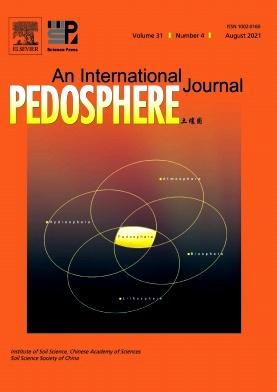Bioaugmentation of a novel bacterial consortium in cotton-planted soil for lambda-cyhalothrin degradation
IF 5.2
2区 农林科学
Q1 SOIL SCIENCE
引用次数: 0
Abstract
Extensive use of lambda-cyhalothrin (LC) for agricultural and domestic pest control leads to the accumulation of its residues in soil and water, which poses a serious threat to the environment. Remediation of LC at the point source is the most effective way to avoid its spread and harmful effects. Therefore, this study was planned to investigate the potential of indigenously isolated bacteria for the remediation of LC in cotton-vegetated soils. Three potent LC-degrading bacteria, Brucella intermedia Halo1, Alcaligenes faecalis CH1S, and Aquamicrobium terrae CH1T, were isolated from a pyrethroid-contaminated soil. A consortium CHST comprising these three strains was found to exhibit a higher potential for LC degradation as compared to the individual strains. The degradation of LC by CHST was optimized for four varying factors, i.e., pH, inoculum density (ID), carbon source (CS), and initial pesticide (i.e., LC) concentration (PC), by applying Taguchi design of experiment. The contributions of these factors to the biodegradation of LC were found to be in the order of pH > CS > PC > ID. The enhanced degradation of LC (84%) was attained at pH 7.0 in minimum salt medium containing 10 mg L-1 LC and 3% inoculum. The consortium CHST was also augmented in sterilized and unsterilized soil microcosms at three PCs, i.e., 2, 5, and 10 mg kg-1. After 21 d of incubation, complete LC degradation was achieved at 2 mg kg-1 PC in sterilized as well as unsterilized soil, whereas at higher PCs, the extent of degradation was comparatively less. At PC of 5 mg kg-1, 88% and 96% LC degradation were observed in sterilized and unsterilized soils, respectively, compared to 79% and 90% degradation at 10 mg kg-1, respectively. During biodegradation, the major metabolite of LC, i.e., 3-phenoxybenzoic acid, was produced and further degraded. In a cotton-planted soil spiked with 10 mg kg-1 LC, the consortium degraded 91.8% LC, as well as improving the agronomic parameters of the cotton plants. In a nutshell, the consortium CHST was found to be a promising candidate for the remediation of LC contamination at the point source.
一种新型菌群在棉花种植土壤中降解高效氯氰菊酯的生物强化研究
高效氯氟氰菊酯(LC)广泛用于农业和家庭病虫害防治,导致其残留在土壤和水中积累,对环境构成严重威胁。对污染源进行点源整治是防止污染源扩散和危害的最有效途径。因此,本研究拟探讨天然分离菌对棉花植被土壤中LC的修复潜力。从拟除虫菊酯类杀虫剂污染的土壤中分离出三种高效的lc降解菌,即中间盐布鲁氏菌(Brucella medium Halo1)、粪碱性菌(Alcaligenes faecalis CH1S)和地生水微生物(aquamicroum terrate CH1T)。与单个菌株相比,由这三种菌株组成的财团CHST表现出更高的LC降解潜力。采用田口试验设计,在pH、接种量(ID)、碳源(CS)和初始农药(即LC)浓度(PC) 4个因素的影响下,对CHST降解LC进行了优化。这些因素对LC生物降解的贡献大小依次为pH >;CS祝辞电脑比;ID。在pH 7.0的最低盐培养基中,含10 mg L-1 LC和3%的接种量,LC的降解率提高了84%。财团CHST在灭菌和未灭菌的土壤微环境中也增加了3个PCs,即2、5和10 mg kg-1。培养21 d后,在灭菌和未灭菌土壤中,2 mg kg-1 PC均能完全降解LC,而在较高PCs时,降解程度相对较小。在5 mg kg-1的PC条件下,灭菌土壤和未灭菌土壤的LC降解率分别为88%和96%,而在10 mg kg-1的PC条件下,LC降解率分别为79%和90%。在生物降解过程中,LC的主要代谢物即3-苯氧苯甲酸被生成并进一步降解。在添加10 mg kg-1 LC的棉花种植土壤中,该组合降解了91.8%的LC,并改善了棉花植株的农艺参数。简而言之,该财团CHST被发现是一个有希望的候选人LC污染的补救点源。
本文章由计算机程序翻译,如有差异,请以英文原文为准。
求助全文
约1分钟内获得全文
求助全文
来源期刊

Pedosphere
环境科学-土壤科学
CiteScore
11.70
自引率
1.80%
发文量
147
审稿时长
5.0 months
期刊介绍:
PEDOSPHERE—a peer-reviewed international journal published bimonthly in English—welcomes submissions from scientists around the world under a broad scope of topics relevant to timely, high quality original research findings, especially up-to-date achievements and advances in the entire field of soil science studies dealing with environmental science, ecology, agriculture, bioscience, geoscience, forestry, etc. It publishes mainly original research articles as well as some reviews, mini reviews, short communications and special issues.
 求助内容:
求助内容: 应助结果提醒方式:
应助结果提醒方式:


